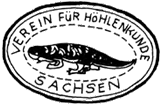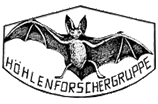| History of Speleology in Saxony |
|
| |
|
| Caves are a very special sort of archives of geology and history. Essentially there are in Saxony sandstone-caves and only a few are limestone-caves. |
|
| |
|
| The oldest written documents concerning caves of Saxony are the result of martial-criminal (robber castles), as well as of kartographic occasions (border marks). |
|
| |
|
| A border-marking document was written in 1474 (it notices the arch-like cave "Prebischtor"). Around 1480 a confession (after torture) revealed caves were used in the robber castles "Frienstein" and "Neuer Wildenstein". |
|
| |
|
| A historic map 1537 shows the cave ZWERGLOCH (LB-32) on the border between Saxony and Bohemia near the village of Eiland. A collapsed cave (DIEBSKELLER, PW-15 in the Kleiner Bärenstein) was used as a landmark for a point of measurement in 1574. |
|
| |
|
| In 1692 BUCHHAEUSER indicated that the bedding plane–cave DIEBSKELLER (KO-08) was used as a tourist site. |
|
| |
|
| The publication "Des unterirdischen Sachsens seltzame Wunder der Natur" (e. g. Curios Wonders of Natur in Saxonys Underground) wrote MYLIUS in 1718. In 1743 a book was written that detailed a description of the bedding plane – cave KUHSTALL (SH-01). SÜSSE 1755 mentions the MÖNCHSLOCH (RA-15), the HÖHLE IN DER NONNE (PW-13), and the o1d mine SPECKSTEINSTOLLN (GK-02). ENGELHARDT & VEITH 1794 gives some further descriptions: below it is the flowing brook HÖHLE AM NEUWEG (RA-09). That text is the oldest karsthydrological observation of Saxony. LAFLEUR wrote another tourist guidebook in 1798; he describes two visits in caves, e. g. AMSELFALLHÖHLE (RA-01). |
|
| |
|
| NICOLAIs guidebook 1801 recommends a visit to the icecave (EISLOCH), near SCHWEDENLOCH Bielatal (RO-02 und RO-10) and mentioned the cave "METZE" in the valley of Kirnitzschtal (SH-08). GÖTZINGER 1804 lists in a geographic guide 23 caves. Ludwig RICHTER 1820 painted some pictures of caves of Saxon Switzerland. MERKEL 1826 described the western Saxonian-Bohemian-Switzerland caves BENNOHÖHLE (LB-24), KLEINEN KUHSTALL (KÖ-27), and ZWERGENHÖHLE near the Langenhennersdorfer waterfall (LB-02). First he described the biological root-stalagmites. These caves had approches with man made sandstone steps. The reasons for the reflecting light of the lighting moss, a remarkable plant in caves of Saxon Switzerland, were found. In 1858 v. GUTBIER explained the genetic types for some sandstone-caves. KRONE 1879, one of the founders of photography, is a founder of speleology in Saxony. He had made some diggings in caves and found in KRONEHÖHLE (SH-57) items from the middle age. Also, he reported on condensation-water-corrosion. HETTNER, 1887 noted the karsttypical sandstone-karren, as well as examples of tectonical and mechanical cave-origins. HERING 1899 built a way to the HERINGSHÖHLE (RA-22) in the Uttewalder Grund. At the end of this century are described approximately 40 Saxon caves in books and other publications. |
|
| |
|
| Since 1910 more and more friends of nature and culture and climbers visited the sandstone rocks. The numbers of known caves grew. The oldest society for Speleology in Eastern Germany (Vereins für Höhlenkunde in Sachsen, 1920), was founded and had many contacts with other regions and cavers. |
|
| |
|
 |
|
| |
|
BEYER 1911 published studies concerning weathering of sandstone by the minerals Alum and Gypsum.
Well known researchers, like MÖRTZSCH, RUSCHER, and HELLER worked systematically together in speleologic questions. They build a cadastre of caves and published a special form to describe caves.
"We need a long time before we can say, there is no cave that we don´t know."
Discovery and opening as a show cave of the DRACHENHÖHLE SYRAU in 1928 brought to Saxony a very nice cave with great dripstones. The speleological interest grew in these years. In 1931 286 caves in Saxony and neighbouring regions, including some artifical rooms (old mines in carstified limestone-quarries) were counted. |
|
| |
|
| The brown-fascistic dictatorship in Germany and Austria took total control of speleological associations and stopped the work in Saxony, too. The famous middle-Europian speleologist Dr. Benno WOLF (born as a Jew in Dresden) was displaced and perished in 1942. |
|
| |
|
| In the red dictatorship under the Communism after World War II the speleological development was very suppressed. The publisher of homeland-infomations LEMME (1959 till 1972) made known caving information. Saxonian speleologists BOERTITZ & EIBISCH published in 1962 many short descriptions of approximately. 100 caves of the Saxon Switzerland. Their genetic ideas and historic information were the basis for the works of Cave Research Group of (HFG), founded on 16. Sept. 1962. |
|
| |
|
 |
|
| |
|
So as soon as possible, we published the "Kataster-Musterblatt", a form for most of the cadastres of caves of Eastern Germany. In 1970 a great study of spiders in sandstone caves was made. Based on 200 sandstone caves, we showed on the International Congress of Speleology the caves types in sandstone.
Since 1977, our group sponsers the annual "RUSCHER-walking-tour", a well known date for every friend of caves. |
|
| |
|
| Between 1975 until 1978 additional Saxon caving groups were founded in Karl-Marx-Stadt (Chemnitz), Lübbenau, Zittau, and Leipzig. (The group of Leipzig is not working in Saxony). |
|
| |
|
| A dictatorial law against caving ("Höhlengesetz") was published in 1985, it stopped free caving in the GDR. Slides-shows and the speleological lectures in evening schools were forbidden. |
|
| |
|
The newsletter DER HÖHLENFORSCHER was published until 1989 illegally. The Cave Research Group of Dresden (HFG) worked in these years, especially in Bohemia, publishing studies concerning sandstone-karst (solution of quartz).
The Saxonian cave-cadastre and bibliography (more than 3900 titles) are since 1992 computerized. Now we know more than 400 caves in Saxony. |
|
| |
|
| "Presumably" there are in Saxony some other associations ("Mitteldeutsche speläologische Gesellschaft e.V."; "Gruppe Elbsandstein"; "Höhlenforschung Dresden"; "Höhlen- und Karstforschung Dresden e.V."; "AG Höhlen- und Karstforschung Freiberg"; "HF Fledermäuse SBB"; "Einseiltechnik an der TU"), but we do not know of any publications of theses groups. In summary, in Saxony between 1970 and 1999 at least 20 different groups of cave-friends, -researchers, -divers, -rescuers, and -tourists finished their trials, to work continuously, besides the Cave Research Group of Dresden (HFG). |
|
| |
|
|
|
Man puts an end to the darkness; he searches the farthest recesses for ore in the blackest darkness. … He tunnels through the rock; his eyes see all its treasures.
(Hiob /Job, 28;3,10) |
|
| |
|
| |
|
| Caves in Saxony |
|
| |
|
| Most of the caves of Saxony are situated in sandstone-areas ("Sächsische Schweiz" and "Zittauer Gebirge"). In the cretacious sandstones, we can find karstic caves (solution of the minerals by water), as well as relative ample rooms with tektonic origin and so called "collapsed caves" (mechanical movements of blocks). They are maximally 44 metres deep and sometimes more than 100 metres long. |
|
As an example we list the register of three areas:
"Erzgebirge / EG-", "Pirna-Weißig / PW-", and "Rathen / RA-" (on both sides of the Elbe River).
|
|
| Much more information you can find in the publications of the publisher DER HÖHLENFORSCHER, e. g.. the book "Durch Höhlen der Sächsischen Schweiz". |
|

